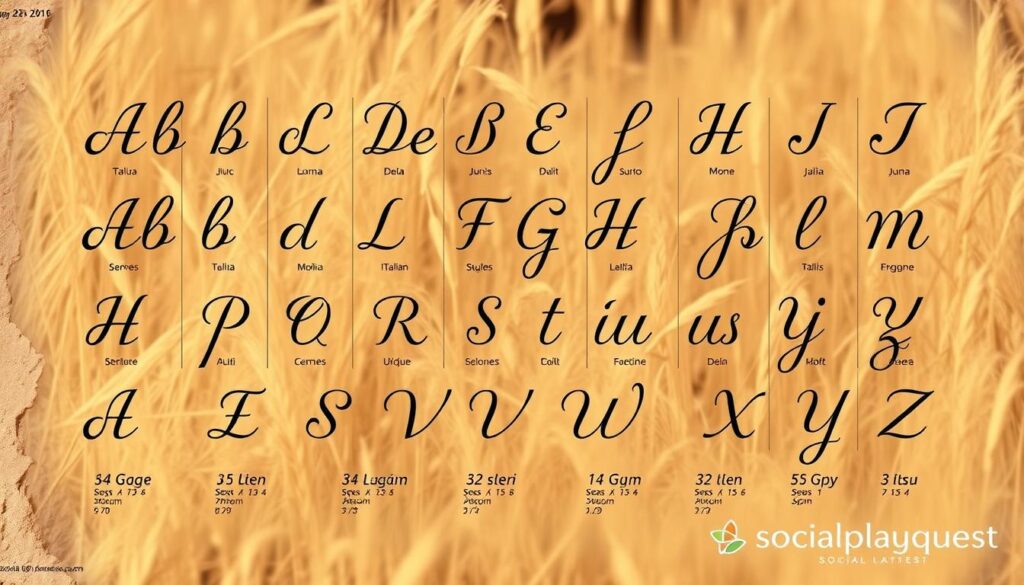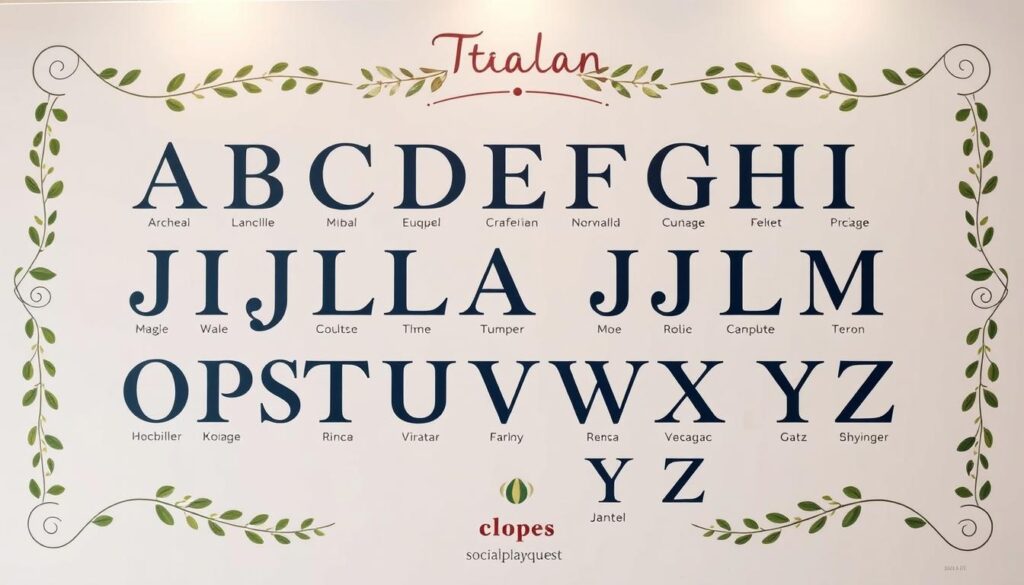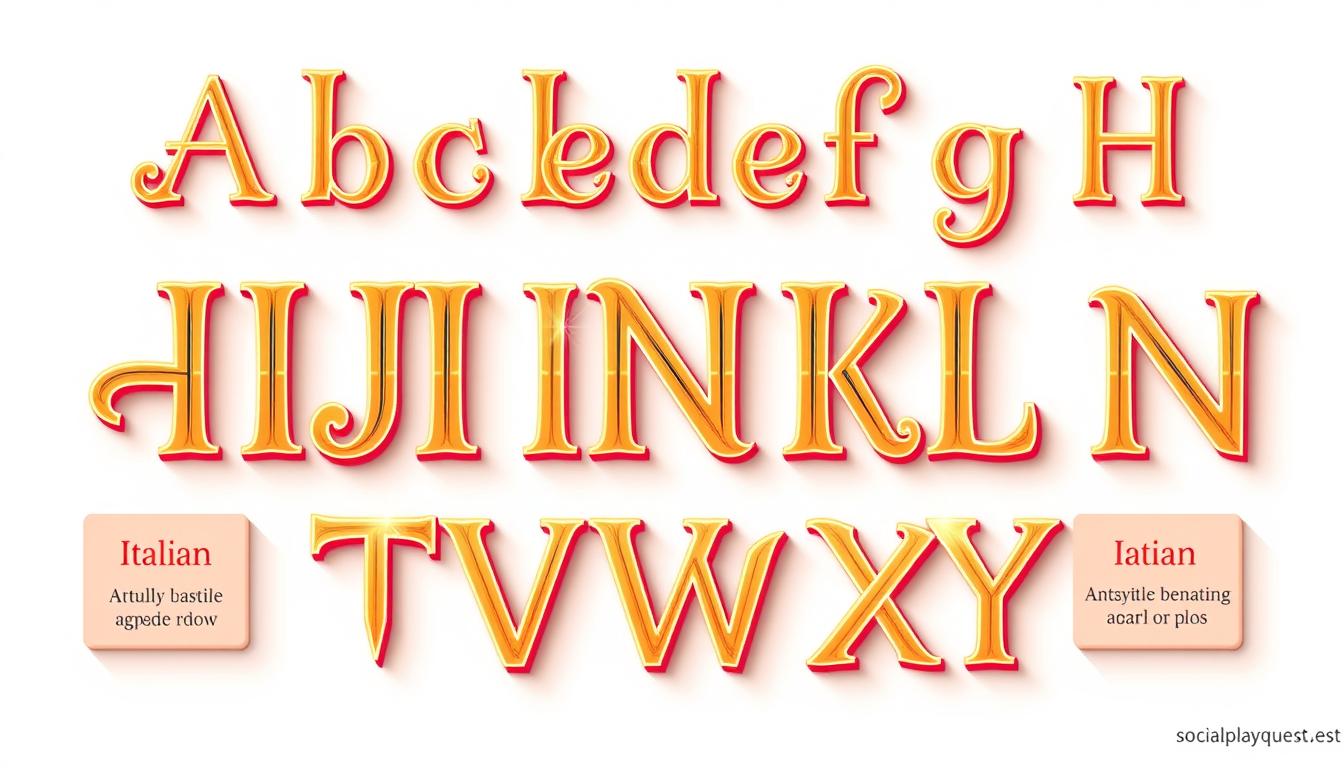Did you know the Italian alphabet holds hidden rules that can turn your pronunciation from awkward to accent-free?
Mastery of the Italian alphabet isn’t just about memorizing letters. It’s the key to mastering vowel sounds, stress patterns, and smooth conversation. With 7 distinct vowel sounds, Italian is more complex than English’s 5-vowel simplicity. This guide will help you learn the Italian alphabet basics without getting confused.
Imagine cutting months off your learning curve. Research shows listening to native audio can improve pronunciation by 30% in just three months. But where do you start? This guide will show you how to understand stress placement, diphthongs, and accent marks. This knowledge can turn mistakes into breakthroughs.
Key Takeaways
Overview of the Italian Alphabet
The Italian alphabet is key to Italian language basics and beginner Italian lessons. It has 21 letters, which is fewer than English’s 26. This makes it easier to pronounce words. Letters like J, K, W, X, and Y are rare, found mainly in words like “jeans” or “kilometro.”
Each letter in the Italian alphabet sounds the same every time. This makes it simpler to read and say words than languages with tricky spellings.
What Makes the Italian Alphabet Unique?
The Italian alphabet is simple because it follows strict rules. Vowels like E and O can change slightly, like in “perché” and “bello.” But consonants like C and G change based on the vowel next to them, as seen in “casa” and “cielo.”
Double consonants, like “bb” or “dd,” make sounds longer and change the word’s meaning. For example, “pala” (shovel) and “palla” (ball) are different. The alphabet’s Latin roots help keep things clear, avoiding silent letters.

The Importance of the Italian Alphabet in Language Learning
Language learning is a skill that needs to be practiced, similar to learning to ride a bike.
Knowing the Italian alphabet is crucial for correct pronunciation. Without it, words like “caffè” (coffee) or “città” (city) might be misheard. Its phonetic nature means spelling can guide you, making learning easier.
Start by practicing with place names: A for Ancona, B for Bologna, and Z for Zeta. Use songs like the alphabet version of “Twinkle Twinkle Little Star” to practice. This helps build muscle memory. With this foundation, you can move on to more complex topics like accents or diphthongs with confidence.
The Letters of the Italian Alphabet
Learning the Italian alphabet begins with 21 main letters and five extra for loanwords. An alphabet chart makes it easy to link each letter to its sound. Knowing how to position your tongue and lips is crucial for correct pronunciation.
A Closer Look at the Basic Letters
Each letter has its own sound and function. Here’s a simple alphabet chart to help you practice:
| Letter | Italian Name | Pronunciation | Example |
|---|---|---|---|
| A | Ah | /a/ (as in “father”) | amico (friend) |
| C | Che | /tʃ/ (as in “chur”) or /k/ (as in “cat”) | cafe (coffee) |
| G | Ge | /dʒ/ (as in “giraffe”) or /g/ (as in “go”) | gatto (cat) |

Vowels like “e” and “o” have different lengths. For example, “e” in “per” is short, but “è” (is) has a stress mark. These differences are essential for understanding the Italian language basics.
The Role of Digraphs in Italian
Digraphs combine two letters into one sound. Here are some common ones:
- CH = /k/ (e.g., “casa” = house)
- GH = /g/ (e.g., “ghiro” = loop)
- GL = /ʎ/ (similar to “lli” in “million”)
- GN = /ɲ/ (as in “lasagna”)
- SC = /ʃ/ or /sk/ (e.g., “scena” = scene)
Getting used to these combinations makes reading easier. Try phrases like “chiama Giovanni” (call Giovanni) to practice “gli” and “gn” sounds.
Pronunciation of Italian Letters
Learning Italian starts with Italian phonetics. Unlike English, Italian has clear rules for vowels and consonants. Each vowel (A, E, I, O, U) has a specific sound. Consonants like R or S have their own patterns. Let’s explore how to get these sounds right.
Vowels vs. Consonants: Key Differences
Italian vowels are always pure and don’t change sounds. They differ from consonants in a big way:
| Vowels | Consonants |
|---|---|
| Always short and distinct (e.g., amore ‘love’) | Classified by articulation: Plosive (e.g., P, T), K),) fricative (e.g., F, S), Z), and rolled sounds like the trilled R |
Common Pronunciation Challenges for English Speakers
- Rolled R: Trilling the tongue for “r” as in ragazzone (big fellow)
- Double consonants: Hold the sound longer (e.g., carro vs. cara)
- Stress patterns: Stress often falls on the second-to-last syllable—misplacing it can change meaning (e.g., ancora = anchor vs. still)
Practice with Italian music or podcasts to train your ear. Remember: Italian’s vowels and consonants work like musical notes—each has its precise pitch. Mastering these basics unlocks clearer communication.
Vowel Sounds in Italian
Italian vowels are the heart of its sound system. Unlike English, each vowel makes a clear sound. This creates a beautiful flow in the language. Italian has five letters: A, E, I, O, U. These letters make seven different sounds, depending on how they are used.
Learning these sounds is key to speaking like a native.
Let’s explore each vowel’s role in speech:
A Deep Dive into the Five Italian Vowels
Each vowel has a unique sound:
- A sounds like “ah” (e.g., “papa” for “father”).
- E has two sounds: open /ɛ/ (like “bed”) and closed /e/ (like “they”).
- I is a sharp “ee” sound, as in “pizza.”
- O can be open /ɔ/ (like “law”) or closed /o/ (like “no”).
- U is pronounced “oo” (e.g., “tu” for “you”).
The Importance of Vowel Length in Meaning
Italian doesn’t have long or short vowels like English. Instead, stress and sound quality change word meanings. For example, “ancora” (anchor) and “ancora” (still/yet) differ in stress.
Practice speaking like a native to understand these differences. Recording yourself helps improve your pronunciation. Regular practice is essential to avoid misunderstandings and master the Italian sound system.
Consonant Sounds in Italian
Learning Italian consonants helps you understand how vowels and consonants work together. Italian consonants have strict rules, making pronunciation clear. Focus on consonants that are different from English.
Essential Consonants You Should Know
| Italian Consonant | English Comparison | Example |
|---|---|---|
| C | Varies (ch/k) | casa (kah-zah) |
| G | Similar to “g” in “go” | gatto (gah-toh) |
| R | Roll the tongue | rosso (roh-soh) |
| Z | Soft “ts” sound | mozza (moots-ah) |
Soft and Hard Consonants Explained
Italian pronunciation depends on knowing soft and hard consonants:
- C: Soft before e/i (ch sound), hard before a/o/u (k sound)
- G: Soft before e/i (j sound), hard before a/o/u (g sound)
- H: Silent, but changes c and g (e.g., chiave = key)
Double consonants (like getto*) make sounds last longer, changing meaning. Try saying “Tre tigri traverse trippa” to practice consonant clusters. Being consistent with Italian phonetics helps you speak better faster.
Special Letters and Digraphs
Learning the Italian alphabet means knowing special letter pairs and foreign characters. These are key for correct pronunciation and spelling. They are part of the
Understanding ‘CH’, ‘GH’, and ‘QU’
These digraphs make sounds not found in single letters. Here’s how they work:
- CH: Makes a hard /k/ sound before E or I. For example, chiesa (church) sounds like “kee-eh-sa.”
- GH: Creates a hard /g/ sound before E or I. For example, ghiro (loop) is pronounced “jee-ro.”
- QU: Always sounds like /kw/, as in quello (that) = “kwel-lo.”
The Italian Letters ‘J’, ‘K’, ‘W’, ‘X’, and ‘Y’
These five letters are not in the basic 21-letter alphabet but show up in loanwords or names. Here’s how they’re used:
| Letter | Common Use | Pronunciation |
|---|---|---|
| J | Loanwords like journal (giornale) | Often sounds like “i” or “gi” (e.g., “Jupiter” = “Giuppiter”) |
| K | Used in foreign terms like kangoo (kangaroo) | Always pronounced as “k” (e.g., “kilo” = “kee-lo”). |
| W | Primarily in foreign names (e.g., “Wiener Schnitzel”) | Usually as “v” or “w” depending on context. |
| X | Found in loans like ex (ex) or xenon | Often as “esz” (e.g., “X” in “taxi” = “taksi”). |
| Y | Used in scientific terms or names like Ypsilon | Generally pronounced as “ee” or “i” (e.g., “Yoda” = “ee-oh-da”). |
These exceptions show the importance of knowing both traditional and modern uses in the learn Italian alphabet process. Practice with loanwords and proper nouns helps with fluency.
The Role of Accents and Diacritics
Learning Italian phonetics means knowing how accents change how we say words. These small marks are not just for looks. They help us understand the meaning and stress of words. Let’s explore how they work in Italian language basics.
How Accents Change Pronunciation
Accents change the meaning and stress of words. For example, ré (king) and re (if) are different because of the acute accent (´). Without it, words can sound the same but mean different things. The grave accent (`) in café (café) vs. cafe (unstressed) shows how stress can change. These marks help us say words correctly, avoiding confusion.
Recognizing Different Types of Accents in Italian
Italian has three main accents:
| Accent Type | Symbol | Usage | Example |
|---|---|---|---|
| Acute Accent | ´ | Stressed close-mid vowels at word ends | café |
| Grave Accent | ` | Open-mid vowels or stressed syllables before final consonants | là (there) |
| Circumflex | ˆ | Rarely used in modern texts, marks vowel contractions | mûso (snout) |
Practice finding these marks in texts. Remember, accents are only needed in specific cases, like è (is) vs. e (and). They guide us to clear pronunciation and avoid confusion.
Integrating the Alphabet into Vocabulary
Learning the Italian alphabet is the first step to growing your vocabulary. Start by making lists of words for each letter. Begin with one letter at a time and learn its role in common words.
Building Your Italian Vocabulary with the Alphabet
Start by linking each of the 21 Italian alphabet letters to 3-5 words. For instance, “A” could be linked to “amore” (love) or “amico” (friend). Create phrases where each word starts with consecutive letters, like “Amo il caffè” (I love coffee) for A, B, C.
Words with double consonants, like “pazzo” (crazy), help with pronunciation and memorization.
Tips for Memorizing Italian Words
- Write by hand: Write down new words every day to help remember letter shapes.
- Context is key: Connect words to things around you, like a “finestra” (window) or “tavolo” (table).
- Read aloud: Practice with children’s books or simple articles to hear how letters sound.
Use beginner Italian lessons on apps like Preply ($10/hour lessons) for alphabet practice. Focus on how letters like “c” and “g” change sounds with vowels. This helps with word recognition. Regular practice turns alphabet knowledge into fluent speaking.
Common Mistakes When Learning the Italian Alphabet
Mistakes occur when learn Italian alphabet basics are ignored. Mastering pronunciation and Italian phonetics requires spotting errors early. This section will cover common mistakes to steer clear of.
Avoiding Pronunciation Pitfalls
- Rolling the ‘r’ like English? Try tongue trills for authentic sounds.
- Speed through double consonants? Pause briefly between letters in ‘bambino’.
- Ignoring stress? Most words stress the second-to last syllable unless marked, like ‘caffè’.
- Silence letters? The ‘h’ in ‘ho’ is silent, while ‘i’ in ‘ghi’ changes the ‘g’ sound.
Resources like Rocket Languages help with tricky sounds.
Miswriting Italian Letters and Words
Writing errors come from not knowing the rules:
- Overusing J, K, W, X, Y outside loanwords or names.
- Ignoring accents: ‘café’ (French) vs. ‘caffè’ (Italian).
- Missing silent letters in ‘ghi’ or ‘sci’ combinations.
“Consistent practice and feedback turn mistakes into progress.” — Language Teaching Experts
Work on being precise. Only capitalize names, and use accents when necessary. Make sure to review rules for silent letters and digraphs.
Resources for Learning the Italian Alphabet
Learning the Italian alphabet needs the right tools. Find apps, websites, and books to help you. They offer practice, native audio, and visual aids to improve your skills.
Recommended Apps and Websites
Apps and online platforms make learning fun and interactive. Start with beginner Italian lessons on Duolingo or Rosetta Stone. They have alphabet drills and pronunciation guides.
For those who like visuals, Italiano.com has free alphabet charts and audio. Many apps also use IPA transcriptions to help with vowel sounds. Italian has 7 different vowel sounds.
Books and Workbooks for Practice
Books and workbooks help with repetition. Here are some great options:
| Resource | Type | Features |
|---|---|---|
| Practice Makes Perfect: Italian Pronunciation | Workbook | Includes alphabet charts, stress pattern exercises, and IPA guides. |
| Conquering Babel | Guide | Packs 12 pro tips on alphabet mastery, including tongue twisters and stress rules. Priced at $3.50. |
“Consistent immersion in native audio improves accuracy by 30% in 3 months.” – Language Acquisition Journal
Use apps like Memrise with workbooks to improve muscle memory. Focus on materials that show stress placement. Even small mistakes in vowel length or alphabet chart recognition can change word meanings. Mix digital tools with physical guides for a well-rounded approach.
Practice Makes Perfect: Exercises
Learning the Italian alphabet needs regular practice. Start with fun activities like tongue twisters or alphabet scavenger hunts. Try writing short stories using each letter or play pronunciation bingo with friends. These exercises make learning fun, helping you remember Italian language basics better.
Take part in beginner Italian lessons like Lucrezia’s YouTube series, seen over 50 million times. Her 8-module course has 4 live workshops and 36 weekly tasks to improve your skills. Use the 1:1 Feedback Plan to track your progress, with personalized audio reviews for each submission.
- Alphabet Hunt: Spot Italian letters in everyday objects and practice their sounds.
- Pronunciation Relay: Recite alphabet letters in rhythm to a beat, boosting memory retention.
- Shadowing Drills: Mimic native speaker recordings to perfect intonation and flow.
Listening is crucial. Watch Italian shows or podcasts and repeat phrases aloud. Record yourself and compare with native audio. Immersing in media builds familiarity with real-world usage. With 700,000+ learners in the community, you’re never alone—join study groups or use app exercises to reinforce skills.
Conclusion: Embracing the Italian Alphabet
Learning the Italian alphabet is the first step to understanding the Italian language. It has 21 letters and sounds are consistent. This makes it easier to tell apart “c” and “ch” sounds.
Every skill you learn, like vowel sounds or consonant pairs, boosts your confidence. The way words like “papa” and “pappa” differ shows how important details are.
The Joys of Learning Italian Through its Alphabet
Knowing the Italian alphabet opens up Italian culture. You can sing opera or read Dante. The 5 vowels are key to pronunciation, making words like “gnocchi” easier to say.
Italian spelling is straightforward, unlike English. This makes learning easier. You can explore dialects and even Neapolitan pizza recipes, where every letter matters.
Next Steps: Continuing Your Italian Language Journey
Once you know the alphabet, start learning new words. Use beginner Italian lessons on Busuu. Practice grammar by studying verb conjugations.
Listen to podcasts or watch films to learn more. Remember, mastering the alphabet is like planting seeds. Consistent practice will help you become fluent. Explore different dialects and accents, and use accent marks to get words like “caffè” right.
With hard work, the alphabet will connect you with native speakers. Every effort will be worth it.

